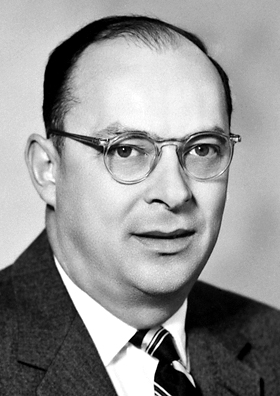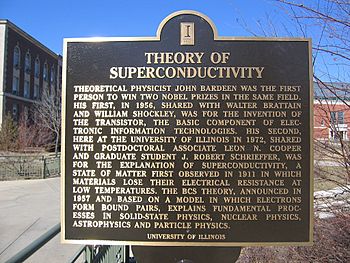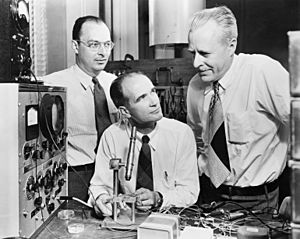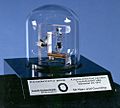John Bardeen facts for kids
Quick facts for kids
John Bardeen
|
|
|---|---|

Bardeen in 1956
|
|
| Born | May 23, 1908 Madison, Wisconsin, U.S.
|
| Died | January 30, 1991 (aged 82) Boston, Massachusetts, U.S.
|
| Education | University of Wisconsin (BS, MS) Princeton University (PhD) |
| Known for |
|
| Spouse(s) |
Jane Maxwell
(m. 1938) |
| Children |
|
| Awards |
|
| Scientific career | |
| Fields | Physics |
| Institutions | Bell Telephone Laboratories University of Illinois at Urbana–Champaign Assistant Professor of Physics at the University of Minnesota-Twin Cities ~1941-1945 |
| Thesis | Quantum Theory of the Work Function (1936) |
| Doctoral advisor | Eugene Wigner |
| Doctoral students |
|
| Influences | John Hasbrouck Van Vleck |
John Bardeen (born May 23, 1908 – died January 30, 1991) was an American physicist and engineer. He is famous for being the only person to win the Nobel Prize in Physics twice!
His first Nobel Prize was in 1956. He won it with William Shockley and Walter Brattain for inventing the transistor. This tiny device changed the world of electronics forever.
His second Nobel Prize was in 1972. He shared it with Leon N. Cooper and John Robert Schrieffer. They won for explaining superconductivity, which is how some materials can conduct electricity with zero resistance. This discovery is used in things like magnetic resonance imaging (MRI) machines.
John Bardeen's inventions helped create almost every modern electronic device, from telephones to computers. His work truly kicked off the Information Age.
Contents
Early Life and Education
John Bardeen was born in Madison, Wisconsin, on May 23, 1908. His father, Charles Bardeen, was the first dean of the University of Wisconsin Medical School.
John went to University of Wisconsin High School and finished when he was 15. He then started studying at the University of Wisconsin in 1923. He chose to study engineering because he thought it had good job opportunities.
He earned his first degree in electrical engineering in 1928. He also got his master's degree in electrical engineering from Wisconsin in 1929.
After college, Bardeen worked as a geophysicist for Gulf Research Laboratories. He helped develop ways to understand magnetic and gravitational surveys. But he soon found this work less interesting.
In 1933, he decided to go back to school. He joined the graduate program in mathematics at Princeton University. There, he studied physics and wrote his thesis on a topic in solid-state physics. He earned his Ph.D. in mathematical physics from Princeton in 1936.
Career and Major Discoveries
Serving During World War II
From 1941 to 1944, John Bardeen worked for the Naval Ordnance Laboratory. He led a team that worked on magnetic mines and torpedoes. They also developed ways to protect against these weapons.
Working at Bell Labs
In 1945, Bardeen joined Bell Labs. He was part of a group trying to find a solid-state replacement for fragile glass vacuum tubes. Vacuum tubes were used to make electronic signals stronger.
At first, their experiments didn't work. Bardeen suggested a new idea about "surface states" on semiconductors. This idea helped the team understand why their experiments failed. They started studying these surface states more closely.
Inventing the Transistor
On December 23, 1947, Bardeen and Walter Brattain made a huge breakthrough. They created the first working point-contact transistor. This device could make electrical signals stronger, just like the vacuum tubes, but it was much smaller and more reliable.
The transistor was a game-changer. It was 50 times smaller than the vacuum tubes it replaced. It used much less power and was far more dependable. This invention made it possible for electronic devices to become much smaller and more portable.
After the invention, there were some disagreements about who deserved the most credit. William Shockley took a lot of the public praise. This made Bardeen and Brattain unhappy. Bardeen left Bell Labs in 1951 to work on other research.
Professor at the University of Illinois

In 1951, Bardeen became a professor at the University of Illinois. He worked in both the Electrical Engineering and Physics departments.
At Illinois, he started two big research programs. One focused on semiconductors, and the other on superconductivity. He was a professor there until 1975, and then became a professor emeritus, meaning he was retired but still involved in research.
Even in his later years, Bardeen kept doing research. He studied how electrons move in special materials called "charge density waves." His ideas about these waves were very advanced.
First Nobel Prize in 1956
In 1956, John Bardeen, William Shockley, and Walter Brattain won the Nobel Prize in Physics. They received the award for their work on semiconductors and for discovering the transistor effect.
Developing the BCS Theory
In 1957, Bardeen worked with Leon Cooper and his student John Robert Schrieffer. Together, they created a theory to explain superconductivity. This theory is known as the BCS theory, named after their initials (Bardeen, Cooper, Schrieffer).
Second Nobel Prize in 1972
In 1972, John Bardeen won his second Nobel Prize in Physics. He shared it with Leon N. Cooper and John Robert Schrieffer for their BCS theory of superconductivity.
This made Bardeen the first person ever to win two Nobel Prizes in the same field (physics). Only a few other people have won more than one Nobel Prize in any field.
Bardeen used some of his Nobel Prize money to fund special lectures at Duke University.
Other Important Awards
Besides his two Nobel Prizes, Bardeen received many other honors:
- In 1952, he won the Franklin Institute's Stuart Ballantine Medal.
- In 1965, he received the National Medal of Science.
- In 1971, he was given the IEEE Medal of Honor.
- In 1973, he became a Foreign Member of the Royal Society.
- In 1977, he received the Presidential Medal of Freedom from President Gerald Ford.
- In 1988, he was awarded the Lomonosov Gold Medal from the Soviet Academy of Sciences.
Advising Xerox
Bardeen was also an important advisor to Xerox Corporation. He encouraged them to keep their research center, Xerox PARC, even when the company wasn't sure about it. This center later became famous for many computer innovations.
Personal Life
John Bardeen married Jane Maxwell on July 18, 1938. They had three children: James, William, and Elizabeth.
Bardeen was known for being a very humble and quiet person. Even though he was a world-famous scientist, his neighbors often just knew him as the friendly guy who hosted cookouts. He enjoyed playing golf and going on picnics with his family.
He once said that science cannot answer the biggest questions about life's meaning. He believed in a strong code of moral values.
Death and Legacy
John Bardeen passed away from heart disease on January 30, 1991, at the age of 82. He is buried with his wife in Forest Hill Cemetery in Madison, Wisconsin.
His work left a huge mark on the world.
- The engineering quadrangle at the University of Illinois is named the Bardeen Quad in his honor.
- Sony Corporation, which greatly benefited from his transistor invention, created a $3 million John Bardeen professorship at the University of Illinois.
- In 2008, the United States honored Bardeen with a special postage stamp as part of the "American Scientists" series. The stamp recognized him for co-inventing the transistor and explaining superconductivity.
As the University of Illinois chancellor said when Bardeen died, "It is a rare person whose work changes the life of every American; John's did."
Images for kids
See also
 In Spanish: John Bardeen para niños
In Spanish: John Bardeen para niños







